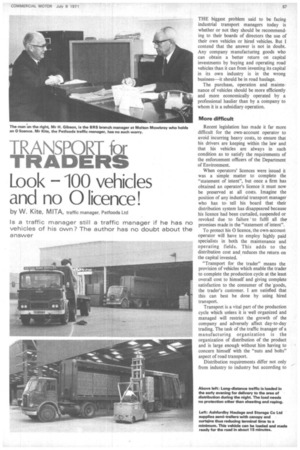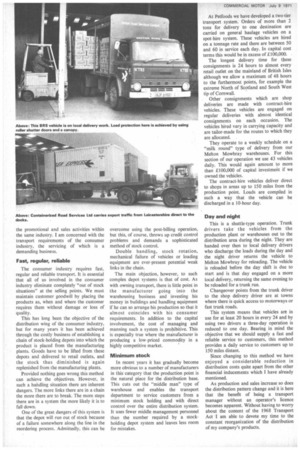TRANSLORTJa TRALPE irvw Look -100 vehicles and no 0 licence!
Page 59

Page 60

If you've noticed an error in this article please click here to report it so we can fix it.
by W. Kite, MITA, traffic manager, Petfoods Ltd Is a traffic manager still a traffic manager if he has no vehicles of his own? The author has no doubt about the answer
THE biggest problem said to be facing industrial transport managers today is whether or not they should be recommending to their boards of directors the use of their own vehicles or hired vehicles. But I contend that the answer is not in doubt. Any company manufacturing goods who can obtain a better return on capital investments by buying and operating road vehicles than it can from investing its capital in its own industry is in the wrong business—it should be in road haulage.
The purchase, operation and maintenance of vehicles should be more efficiently and more economically operated by a professional haulier than by a company to whom it is a subsidiary operation.
More difficult
Recent legislation has made it far more difficult for the own-account operator to avoid incurring heavy costs, to ensure that his drivers are keeping within the law and that his vehicles are always in such condition as to satisfy the requirements of the enforcement officers of the Department of Environment.
When operators' licences were issued it was a simple matter to complete the "statement of intent", but once a firm has obtained an operator's licence it must now be preserved at all costs. Imagine the position of any industrial transport manager who has to tell his board that their distribution system has disappeared because his licence had been curtailed, suspended or revoked due to failure to fulfil all the promises made in the "statement of intent".
To protect his 0 licence, the own-account operator will have to employ highly paid specialists in both the maintenance and operating fields. This adds to the distribution cost and reduces the return on the capital invested.
"Transport for the trader" means the provision of vehicles which enable the trader to complete the production cycle at the least overall cost to himself and giving complete satisfaction to the consumer of the 'goods, the trader's customer. I am satisfied that this can best be done by using hired transport.
Transport is a vital part of the production cycle which unless it is well organized and managed will restrict the growth of the company and adversely affect day-to-day trading. The task of the traffic manager of a manufacturing organization is the organization of distribution of the product and is large enough without him having to concern himself with the "nuts and bolts" aspect of road transport.
Distribution requirements differ not only from industry to industry but according to the promotional and sales activities within the same industry. I am concerned with the transport requirements of the consumer industry, the servicing of which is a demanding business.
Fast, regular, reliable The consumer industry requires fast, regular and reliable transport. It is essential that all of us involved in the consumer industry eliminate completely "out of stock situations" at the selling points. We must maintain customer goodwill by placing the products as, when and where the customer requires them without damage or loss of quality.
This has long been the objective of the distribution wing of the consumer industry, but for many years it has been achieved through the costly business of establishing a chain of stock-holding depots into which the product is placed from the manufacturing plants. Goods have to be lifted from these depots and delivered to retail outlets, and the stock thus diminished is again replenished from the manufacturing plants.
Provided nothing goes wrong this method • can achieve the objectives. However, in such a handling situation there are inherent dangers. The more links there are in a chain the more there are to break. The more steps there are in a system the more likely it is to fall down.
One of the great dangers of this system is that the depot will run out of stock because of a failure somewhere along the line in the reordering process. Admittedly, this can be overcome using the post-billing operation, but this, of course, throws up credit control problems and demands a sophisticated method of stock control.
Double handling, stock rotation, mechanical failure of vehicles or loading equipment are ever-present potential weak links in the chain.
The main objection, however, to such complex depot systems is that of cost. As with owning transport, there is little point in the manufacturer going into the warehousing business and investing his money in buildings and handling equipment if he can so arrange his production so that it almost coincides with his consumer requirements. In addition to the capital involvement, the cost of managing and manning such a system is prohibitive. This is especially true where the manufacturer is producing a low-priced commodity in a highly competitive market.
Minimum stock In recent years it has gradually become more obvious to a number of manufacturers in this category that the production point is the natural place for the distribution base. This cuts out the "middle man" type of warehouse and enables the transport department to service customers from a minimum stock holding and with direct control over the entire distribution system. It uses fewer middle management personnel than the number required by a stockholding depot system and leaves less room for mistakes. At Petfoods we have developed a two-tier transport system. Orders of more than 2 tons for delivery to one destination are carried on general haulage vehicles on a spot-hire system. These vehicles are hired on a tonnage rate and there are between 50 and 60 in service each day. In capital cost terms this would be in excess of £100,000.
The longest delivery time for these consignments is 24 hours to almost every retail outlet on the mainland of British Isles although we allow a maximum of 48 hours to the furthermost points, for example the extreme North of Scotland and South West tip of Cornwall.
Other consignments which are shop deliveries are made with contract-hire vehicles. These vehicles are engaged on regular deliveries with almost identical consignments on each occasion. The vehicles hired vary in carrying capacity and are tailor-made for the routes to which they are allocated.
They operate to a weekly schedule on a "milk round" type of delivery from our Melton Mowbray warehouses. For this section of our operation we use 43 vehicles daily. This would again amount to more than £100,000 of capital investment if we owned the vehicles.
The contract-hire vehicles deliver direct to shops in areas up to 150 miles from the production point. Loads are compiled in such a way that the vehicle can be discharged in a 10-hour day.
Day and night
This is a shuttle-type operation. Trunk drivers take the vehicles from the production plant or warehouses out to the distribution area during the night. They are handed over then to local delivery drivers who discharge the loads during the.day and the night driver returns the vehicle to Melton Mowbray for reloading. The vehicle is reloaded before the day shift is due to start and is that day engaged on a more local delivery, returning the same evening to be reloaded for a trunk run.
Changeover points from the trunk driver to the shop delivery driver are at towns where there is quick access to motorways or fast trunk roads.
This system means that vehicles art in use for at least 20 hours in every 24 and by using two drivers a three-day operation is reduced to one day. Bearing in mind the objective that we should supply a fast and reliable service to customers, this method provides a daily service to customers up to 150 miles distant.
Since changing to this method we have enjoyed a considerable reduction in distribution costs quite apart from the other financial inducements which I have already mentioned.
As production and sales increase so does the distribution pattern change and it is here that the benefit of being a transport manager without an operator's licence becomes apparent. Without having to worry about the content of the 1968 Transport Act •I am able to devote my time to the constant reorganization of the distribution of my company's products.












































































































































